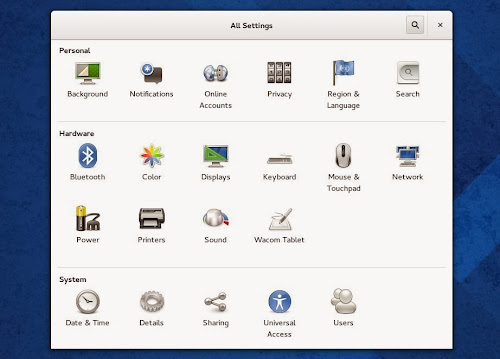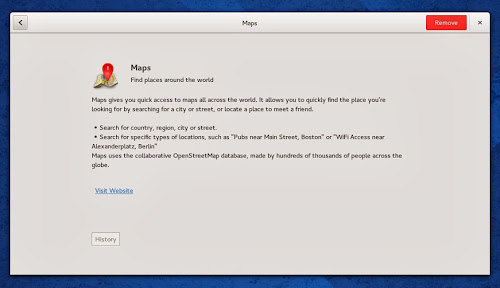Fedora 20 "Heisenbug" has been released, featuring the latest stable GNOME 3.10 along with other interesting changes.
GNOME 3.10
Fedora 20 ships with GNOME 3.10 by default, with comes with some important changes:
- the old system status menus have been replaced with a new System Menu
- improved login and lock screens: better layout, nicer transitions, prettier lock screen notifications, etc.;
- "header bars" or "client side decorations" are used by default by some of the GNOME core apps like Nautilus, Documents and so on;
- many Settings (Control Center), including: new option to change the login screen background, new date and time settings, new display settings, the background can be selected from your Flickr photos;
- fine grained scrolling when dragging the scroll bar handle, or scrolling while holding the shift key;
- and of course, updated core apps.
GNOME Software, a new application that was introduced with GNOME 3.10, is used by default in Fedora 20, replacing the old gnome-packagekit frontends:
This is a tool for browsing and installing applications and at the moment, it doesn't support reviews or displaying application screenshots:
Other changes
- ARM is now an officially supported architecture;
- You can now run ARM VMs on x86 hosts using standard libvirt tools: libvirt virsh, virt-manager and virt-install;
- Cinnamon 2.0 is available in the Fedora 20 official repositories - more about Cinnamon 2.0, HERE. To install the complete Cinnamon desktop in Fedora (including Nemo, etc.), use yum groupinstall "Cinnamon Desktop", then select Cinnamon from the login screen;
- The latest E17 (0.18) stable desktop is available in the Fedora 20 repositories - to install it, use "yum install @enlightenment" and select it from the login screen;
- Network Manager improvements:
- users are now able to add, edit, delete, activate and deactivate network connections via command line using the "nmcli" tool;
- support for bonding and bridging interfaces;
- experimental support for adding solid state drives (SSDs) as fast, transparent caches to traditional HDDs;
- Fedora 20 has migrated to BlueZ 5;
- Sendmail and Syslog have been removed from the minimal installation and from the Live Desktop DVD - systemd journal now takes the place as the default logging solution;
- For the KDE spin, Fedora 20 uses KDE Plasma workspaces 4.11 with a new Plasma-nm applet for network management and a new display manager called SDDM (a lightweight display manager that uses QML for the user interface), replacing KDM.
Default applications
Fedora 20 ships with the following default packages: Nautilus 3.10.1, GNOME Control Center (System Settings) 3.10.2, GNOME Settings Daemon 3.10.2, Evolution 3.10.2, GNOME Documents 3.10.1, GNOME Clocks 3.10.1, Empathy 3.10.2, Totem 3.10.1, Cheese 3.1.2, Rhythmbox 3.0, Firefox 25, Shotwell 0.15.0 and LibreOffice 4.1.3.2, among others, on top of GNOME 3.10 with GTK 3.10.4, Linux Kernel 3.11.10, Mesa 9.2.3 (with 9.2.4 available as an update) and Xorg Server 1.14.4
GNOME 3 applications such as Maps, Bijiben, Weather, Photos, Web (Epiphany), Music, Boxes or Tweak Tool are not installed by default but the latest 3.10 version is available to install from the Fedora 20 repositories:
Download Fedora 20
Before installing Fedora 20, make sure you check out the list of common bugs. Also check out the official release notes.
And as usual, to install codecs, Java and various tweaks, use Fedora Utils.











